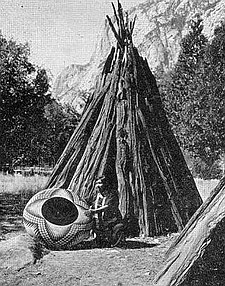
Chinese art is visual art that originated in or is practiced in China, Greater China or by Chinese artists. Art created by Chinese residing outside of China can also be considered a part of Chinese art when it is based on or draws on Chinese culture, heritage, and history. Early "Stone Age art" dates back to 10,000 BC, mostly consisting of simple pottery and sculptures. After that period, Chinese art, like Chinese history, was typically classified by the succession of ruling dynasties of Chinese emperors, most of which lasted several hundred years. The Palace Museum in Beijing and the National Palace Museum in Taipei contains extensive collections of Chinese art.

Ink wash painting ; is a type of Chinese ink brush painting which uses washes of black ink, such as that used in East Asian calligraphy, in different concentrations. It emerged during the Tang dynasty of China (618–907), and overturned earlier, more realistic techniques. It is typically monochrome, using only shades of black, with a great emphasis on virtuoso brushwork and conveying the perceived "spirit" or "essence" of a subject over direct imitation. Ink wash painting flourished from the Song dynasty in China (960–1279) onwards, as well as in Japan after it was introduced by Zen Buddhist monks in the 14th century. Some Western scholars divide Chinese painting into three periods: times of representation, times of expression, and historical Oriental art. Chinese scholars have their own views which may be different; they believe that contemporary Chinese ink wash paintings are the pluralistic continuation of multiple historical traditions.

The art of paper cutting in China may date back to the 2nd century CE, when paper was invented by Cai Lun, a court official of the Eastern Han dynasty.

Chinese folk art or Chinese handcrafts are artistic forms inherited from a regional or ethnic scene in China. Usually there are some variation between provinces. Individual folk arts have a long history, and many traditions are still practiced today. The general definition of folk art incorporates Chinese art forms that are not classified as Chinese fine art.
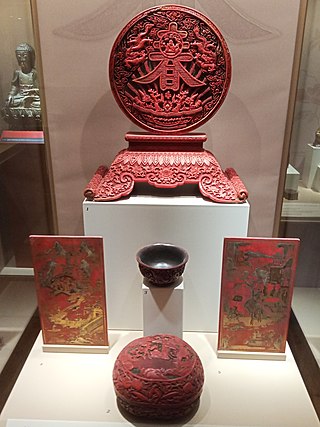
Lacquerware are objects decoratively covered with lacquer. Lacquerware includes small or large containers, tableware, a variety of small objects carried by people, and larger objects such as furniture and even coffins painted with lacquer. Before lacquering, the surface is sometimes painted with pictures, inlaid with shell and other materials, or carved. The lacquer can be dusted with gold or silver and given further decorative treatments.

The history of Asian art includes a vast range of arts from various cultures, regions, and religions across the continent of Asia. The major regions of Asia include Central, East, South, Southeast, and West Asia.

Korean arts include traditions in calligraphy, music, painting and pottery, often marked by the use of natural forms, surface decoration and bold colors or sounds.
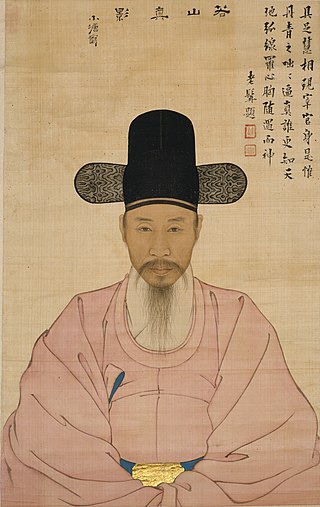
Korean painting (Korean: 한국화) includes paintings made in Korea or by overseas Koreans on all surfaces. The earliest surviving Korean paintings are murals in the Goguryeo tombs, of which considerable numbers survive, the oldest from some 2,000 years ago, with varied scenes including dancers, hunting and spirits. It has been hypothesized the Takamatsuzuka Tomb in Japan, from the 7th-century end of the Goguryeo period, has paintings with Goguryeo influence, either done by Goguryeo artists, or Japanese one trained by Goguryeo people. Since a lot of influences came into the Korean peninsula from China during the Three Kingdoms period. Until the Joseon dynasty the primary influences came from Chinese painting though done with Korean landscapes, facial features, Buddhist topics, and an emphasis on celestial observation in keeping with the rapid development of Korean astronomy.

The history of Cambodian art stretches back centuries to ancient times, but the most famous period is undoubtedly the Khmer art of the Khmer Empire (802–1431), especially in the area around Angkor and the 12th-century temple-complex of Angkor Wat, initially Hindu and subsequently Buddhist. After the collapse of the empire, these and other sites were abandoned and overgrown, allowing much of the era's stone carving and architecture to survive to the present day. Traditional Cambodian arts and crafts include textiles, non-textile weaving, silversmithing, stone carving, lacquerware, ceramics, wat murals, and kite-making.

The forms of Chinese furniture evolved along three distinct lineages which date back to 1000 BC: frame and panel, yoke and rack and bamboo construction techniques. Chinese home furniture evolved independently of Western furniture into many similar forms, including chairs, tables, stools, cupboards, cabinets, beds and sofas. Until about the 10th century CE, the Chinese sat on mats or low platforms using low tables, but then gradually moved to using high tables with chairs.
The Arts in the Philippines are all the arts in the Philippines, from the beginning of civilization to the present. They reflect a range of artistic influences on the country's culture, including indigenous art. Philippine art consists of two branches: traditional and non-traditional art. Each branch is divided into categories and subcategories.

The Wanshou Temple is a temple located at No.121, Wanshousi Road, Zizhuyuan Subdistrict, Haidian District, Beijing. In addition to being a Buddhist temple, the Wanshou Temple also houses the Beijing Art Museum.

Bhutanese art ༼འབྲུག་པའི་སྒྱུ་རྩལ༽ is similar to Tibetan art. Both are based upon Vajrayana Buddhism and its pantheon of teachers and divine beings.

The Qinhuai Lantern Fair, also known as Jinling Lantern Fair, Jinling Lantern Festival, and officially named Lantern Fair on Qinhuai River, is a popular folk custom celebration of the Lantern Festival in the Nanjing area.

Much traditional Chinese art was made for the imperial court, often to be then redistributed as gifts. As well as Chinese painting, sculpture and Chinese calligraphy, there are a great range of what may be called decorative or applied arts. Chinese fine art is distinguished from Chinese folk art, which differs in its style and purpose. This article gives an overview of the many different applied arts of China.
Bamboo weaving is a form of bambooworking and a traditional craft of Taiwan.
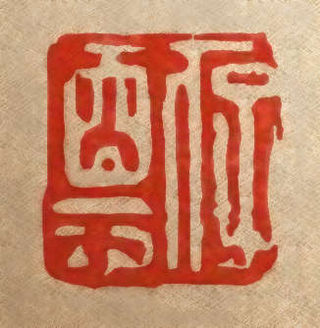
Hu Zhengyan was a Chinese artist, printmaker and publisher. He worked in calligraphy, traditional Chinese painting, and seal-carving, but was primarily a publisher, producing academic texts as well as records of his own work.
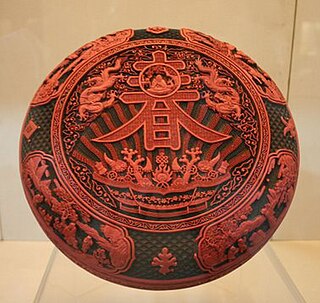
Carved lacquer or Qidiao is a distinctive Chinese form of decorated lacquerware. While lacquer has been used in China for at least 3,000 years, the technique of carving into very thick coatings of it appears to have been developed in the 12th century CE. It is extremely time-consuming to produce, and has always been a luxury product, essentially restricted to China, though imitated in Japanese lacquer in somewhat different styles. The producing process is called Diaoqi.

Suzhou embroidery, Su embroidery or Su xiu is the embroidery created around the city of Suzhou, Jiangsu, China. It is one of the oldest embroidery techniques in the world and is the most representative type of art in Chinese embroidery. One of the well-known "four great embroideries of China" along with Cantonese embroidery, Sichuan embroidery and Xiang embroidery, Suzhou embroidery already has a history more than 2,000 years and is an important form of handicraft in the history of Chinese art and folk custom, representative of Chinese traditional folk arts. It is famous for its variety of stitches, beautiful patterns, elegant colors, and consummate craftsmanship.

Handicrafts produced during the Qing dynasty (1644–1911) were objects designed and hand-made by craftsmen. They were heavily ornate, incorporating Tibetan, Middle Eastern, Indian, and European techniques. The design or decorative aspect of the craft was as important as the crafting technique itself and Qing artisans were particular about the materials they used, such as jade (yu), stones, and wood. In their designs artisans drew heavily from a number of motifs, both mythical and natural. Certain areas in China became well-known for specific types of handicrafts; for example, Jingdezhen was known as the capital of porcelain. During the Qing era, Imperial Workshops built in Beijing brought together artisans and raw materials that were once only obtainable in disparate regions. This allowed for the combining of technologies and materials to produce new types of handicrafts. The tributary system also brought new sources for materials and artisans that were not from the production centers.






